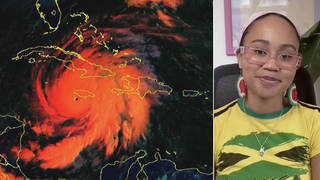
By Amy Goodman and Denis Moynihan
Four hundred years ago, in August 1619, the slave ship White Lion moored at Point Comfort on the James River in Virginia and deposited its human cargo, the first enslaved Africans brought to what would become the United States. Four centuries later, on the first day of Black History Month, the white governor of Virginia, Ralph Northam, was answering questions about whether or not he wore blackface while in medical school. Northam’s personal page in the 1984 Eastern Virginia Medical School yearbook included a photo with two people — one man in blackface standing next to another person in a Ku Klux Klan outfit. Northam first said he may have been one of the two in the photo. The next day, in a news conference, he denied being in the photo, and defied growing calls for him to resign as governor.
“I am not either of the people in that photo,” he said with his wife by his side. Later in his statement, he admitted: “That same year, I did participate in a dance contest in San Antonio in which I darkened my face as part of a Michael Jackson costume. I look back now and regret that.”
Northam is not the only politician recently confronted with blackface in his past. Florida Secretary of State Michael Ertel resigned on Jan. 28, after just two weeks in office, when photos surfaced of him from a 2005 Halloween party. Ertel was in blackface, dressed as a woman, with a shirt that read “Katrina Victim,” just over two months after the Category 5 hurricane devastated New Orleans and the Gulf Coast, killing thousands of people, disproportionately the poor and people of color.
“Amateur blackface minstrelsy was the number one entertainment form throughout the 19th century and the 20th century,” Rhae Lynn Barnes said on the “Democracy Now!” news hour. The Princeton professor’s forthcoming book is titled “Darkology: When the American Dream Wore Blackface.” She went on, describing role of women in combating the practice of blackface in U.S. society:
“Every day black mothers, during the civil-rights movement, in the 1950s and the 1960s, fought to shut down blackface. … They worked with the NAACP and said, ‘We need to outlaw this so that it’s no longer in our schools, it’s no longer in government spaces.’ And there was a lot of pushback to these black mothers, especially from the men in the civil-rights movement, who said: ‘We need to focus on voting rights. We need to focus on anti-lynching.’ And these black mothers said: ‘No, my son was lynched because of these stereotypes, because of these grotesque representations that objectify African-Americans. This is the thing of the thing, the seed of the seed, that allows racism to thrive in America, and it needs to be stopped.’
“They were successful,” Professor Barnes concluded, “and because of that success, blackface has become so taboo that most Americans don’t know the through line of how and why these stereotypes were transmitted to us.”
The calls from Democrats for Northam to resign were almost universal, from the Virginia Democratic Party to former Democratic governors of the state, to the commonwealth’s two current U.S. senators, to organizations that long supported him, like the Planned Parenthood Federation of America.
PPFA’s new president, Dr. Leana Wen, said in a statement: “Governor Northam is also Dr. Northam. As a physician myself, I thought a lot about what this means for him to appear like this during medical school and how that reflects on the patient care he and his classmates might provide.”
The same 1984 yearbook from Eastern Virginia Medical School had at least two other photos of white students in blackface. The school stopped producing yearbooks after the 2013 edition, which included three photos of students dressed as Confederate soldiers in front of the Confederate battle flag. “I want to express my sincere apologies, particularly to the African-American communities,” EVMS President Richard Homan, M.D., said Tuesday.
Racist attitudes like those expressed in the yearbooks might help explain why African-American patients in the United States are actually given fewer painkilling medications than white patients. A 2016 University of Virginia study found that a substantial number of white medical students and residents hold “beliefs about biological differences between blacks and whites … beliefs dating back to slavery — associated with the perception that black people feel less pain than do white people.”
On Wednesday, Virginia’s attorney general, Democrat Mark Herring, admitted that he, too, wore blackface at a 1980 college party. This, in the same state where hundreds of white supremacists, Klansmen and neo-Nazis marched less than two years ago, in Charlottesville, attacking counterprotesters and killing one of them.
The legacy of slavery in the United States lives on in countless, often deadly, ways. Racism, like the shoe polish Gov. Northam used on his face, can’t simply be scrubbed away.











Media Options